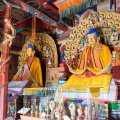ERDENE ZUU MONASTERY
If there was only one historical site to visit in Mongolia, it would probably be this one. A rich history, a magnificent complex, a unique scenery, especially at dusk: one cannot visit Mongolia without being immersed in the history and culture of this country in Kharkhorin, and especially within these walls. The construction of the monastery began in 1586, following the instructions of Avdai Sain Khan, in order to house tangka (silk painting) which had been offered by the Dalai Lama to the Great Khan of Mongolia. At first, three temples were erected, and then buildings were added to the interior of the enclosure as generations of monks and great khans followed one another. More than 62 large temples stood in the monastery compound in 1872, and their number continued to grow until the late 1930s, when the Soviets practically razed the entire monastery. At the time of its greatest activity, a thousand monks resided in the monastery compound. It was not until the early 1990s and the end of Soviet influence that monks were again allowed to reside there.
The presentation below follows the classic order of the visit, entering the enclosure through the southern gate.
The courtyard of the monastery still contains a few steles, one of which shows the Soyombo (national symbol invented by Zanabazar). Turkish writings on one side and Tibetan, Sanskrit and Mongolian writings on the other side are visible.
The temple of the Dalai Lama. This is the first temple that one comes across when starting the visit in a clockwise direction. Built in 1675, it is covered with brick and gold ceramics. It is composed of small prayer chapels and protected on the north side by wooden barriers intended to keep away evil spirits.
The three temples of Avdai Sain Khan. One enters then in a court located on the back of the temple of the Dalaï-lama. The ground is divided into a multitude of small huts. Each one was once used as a meditation space for a monk. The three temples are easily recognizable by their typical Chinese architecture. At the end of the courtyard on the left, stands the western temple, Baruun Züü. It houses three Buddha statues: Kasyapa (left), Sakyamuni (the original Buddha of the religion, in the center) and Matreya (right).
The main temple, with its completely restored façade, also has three main statues. It is the largest and the oldest. It reaches 15 meters high. The statues represent Amitabba, Sakyamuni and Manal, the Medicine Buddha. The entrance of the temple is framed by two imposing statues of the protective deities of the place, Gombogur Dhrama (left) and Baldanlham (right). Behind them, on the sides, are statues representing the disciples of Buddha. Some masks worn during religious dances(tsam) are also displayed inside this temple.
The temple at the end of the courtyard on the right is simply called the Eastern Züü Temple. It houses three statues, those of Aryapala, Sakyamuni and Je Zonkhapa, recognizable by his yellow cap. It is besides him who is at the origin of this symbol. Finally, the first temple, on the right as you enter the courtyard, has a mural fresco, several statues of Buddhist deities and tangka.
The golden stupa . Once out of the small enclosure of the three temples, one finds a little further the golden stupa, built in 1799 in the honor of the fourth Bogd Khan. Surrounded by eight small stupas, it is 10.5 meters high and contains 100,000 Buddha statues. The tombs of Avdai Sain Khan and his grandson, Tusheet Khan Gombodorj, are also located within its walls.
To the east of this Chinese temple is the only remaining temple of the monastery. Its architecture is typically Tibetan, like a labrang. Built in 1760, it served as the residence of the Bogd Khan when he went to Erdene Züü. Only the first floor, which offers a small prayer room, is accessible. The upper part, dedicated to Mahâkala, is closed to visitors.
Some traces remain of the impressive ger that was installed in the heart of the enclosure in 1657 by Zanabazar. Called Bat Ulziit, this ger measured 45 meters in diameter and about 15 meters high. It required 35 removable walls and 1,700 poles for the roof! It was later moved, and its first location was converted into a stage for tsam ceremonies. Today we can see the location of the seven poles out of the original eight.
The prayer yurt. In the middle of the monastery, you will find a yurt where monks pray for the public. You can, for a symbolic contribution, order a prayer from them. You just have to give your first name and the monk will make a prayer for you in Tibetan. You can ask that it brings you luck, happiness, love, money... It lasts on average 5 minutes and you will hear your name regularly pronounced in a religious chant in Tibetan. The practicing Buddhists will be able, as for them, to go to pray in the temple in activity on the spot.
The enclosure is delimited by a white wall with 108 stupas. Measuring 400 meters on each side and forming a square, this wall was built more than a century after the original monastery. Its construction began around 1730 and was completed in 1808.
Did you know? This review was written by our professional authors.
Book the Best Activities with Get Your Guide
Members' reviews on ERDENE ZUU MONASTERY
The ratings and reviews below reflect the subjective opinions of members and not the opinion of The Little Witty.


Pas de photos où il faut payer comme dans tous les temples en Mongolie.